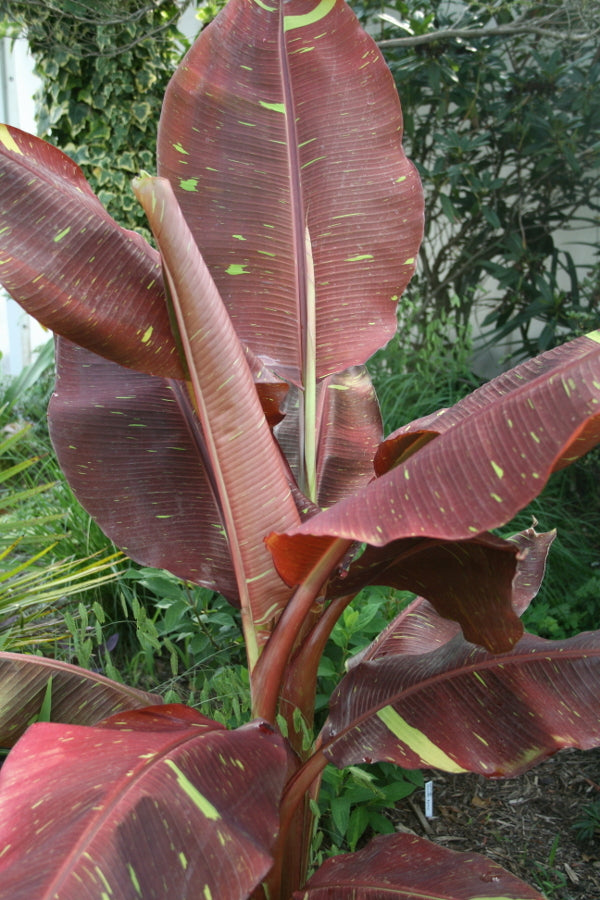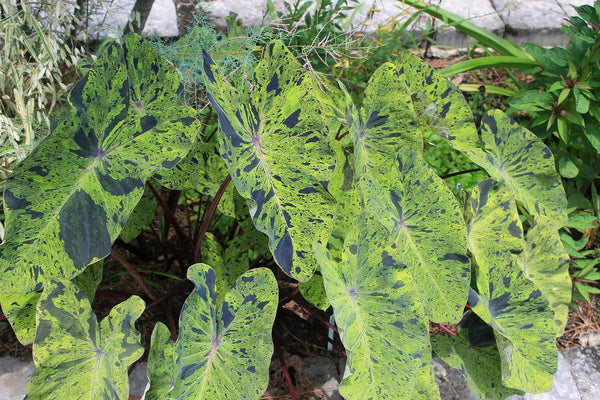 Musa 'Siam Ruby'
Musa 'Siam Ruby'
If you are growing banana trees that aren’t winter hardy in your climate, you have three good options for overwintering them. The first is to pot your banana plant and keep it indoors where the temperature remains between 40 and 70 degrees F. If your banana plant is too tall, it can be cut back to the ground without any adverse effects. If you store your banana plant where the temperatures remain steady between 40-50F, it can be kept in reduced light levels since growth will be minimal. If the storage temperatures are above 50F, the banana tree will be actively growing and will need brighter light to keep the plant healthy.
Banana trees that have a trunk diameter of 6” or greater can be dug just prior to frost and layed sideways without any soil on the roots. This is best done in a cellar, crawlspace, under a greenhouse bench or similar area. The best storage temperature for this to work is around 40-50 degrees F.
The third option is to leave the banana tree in the ground and build a wire cage around it. Concrete reinforcing wire is best, due to its sturdiness. The wire cage should be 4’ tall, and there needs to be 2’ distance from the wire to the outside trunk of the banana. We find it best to install the cage just after the first light frost. The cage should then be filled with shredded leaves. The shredding allows the leaves to pack properly, releasing some heat, and not holding too much moisture. We have not found any other organic materials that have been successful in overwintering bananas in cages. The cages are subsequently removed after last frost in spring. (Check out our detailed banana article)
 Colocasia esculenta 'Mojito' PP 21,995
Colocasia esculenta 'Mojito' PP 21,995
The process for overwintering elephant ears is similar to that for banana trees. The best option is to pot elephant ears and bring them indoors for overwintering. While the old style elephant ears (like Colocasia esculenta ‘Jack’s Giant’) will form large tubers and can be stored dry in peat moss at temperatures around 45-50 degrees F, the new, fancier colored-leaf forms never form a large enough tuber to be stored dry. When potted and kept at temperatures around 45-50F, they can be stored in low light since growth will be minimal. When temperatures are kept above 50F, potted elephant ears will need more light, since the plants will be actively growing. Watch for spider mites when growing potted elephant ears indoors. Spider mites will appear as tiny spider webs on the back of the leaves accompanying a white flecking pattern on the leaf backs. There are a number of treatments for these, but we recommend starting with an insecticidal soap, then if needed, move to an insecticidal oil spray…both applied to the leaf back.
If you live in an area where elephant ears are marginally hardy, you can pile shredded leaves overtop of your clump to give a slight boost to winter hardiness. Leaf piles should be at least 12-18” deep. Small cages similar to those we recommended for bananas will also work. (Check out our detailed elephant ear article)
Other plants such as canna lilies and calla lilies, if grown outside of their hardiness zones, are best dug and stored dry. Dig canna and calla lilies after a light frost and allow the tubers to dry for a few days. At this time, shake off the loose soil and store them in a breathable bag in dry peat moss. The best temperature for storing cannas and callas dormant is 40-50 degrees F. Cannas can also be potted as we recommended for elephant ears. (Check out our detailed canna lily article)



